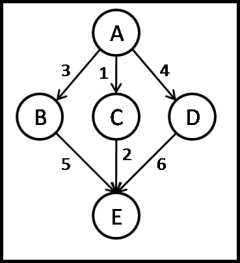k.inabaさんおすすめの『最短経路の本』でグラフ理論の勉強中。
Boost.Graphで最短経路の計算。
#include <iostream> #include <vector> #include <string> #include <boost/graph/graph_traits.hpp> #include <boost/graph/adjacency_list.hpp> #include <boost/graph/dijkstra_shortest_paths.hpp> #include <boost/graph/graph_utility.hpp> #include <boost/spirit/home/phoenix/algorithm.hpp> using namespace boost; typedef adjacency_list<listS, vecS, directedS, no_property, property<edge_weight_t, int> > Graph; typedef std::pair<int, int> Edge; typedef graph_traits<Graph>::vertex_descriptor Vertex; enum { A, B, C, D, E, N }; const std::string name = "ABCDE"; const int vertex_count = N; int main() { // 辺 std::vector<Edge> edges = { {A, B}, {A, C}, {A, D}, {B, E}, {C, E}, {D, E} }; // 距離 std::vector<int> weights = { 3, 1, 4, 5, 2, 6 }; // グラフ作成 Graph g(edges.begin(), edges.end(), weights.begin(), vertex_count); // 最短経路を計算 std::vector<Vertex> p(num_vertices(g)); dijkstra_shortest_paths(g, A, visitor(make_dijkstra_visitor(record_predecessors(&p[0], on_edge_relaxed())))); // 結果を表示 adjacency_list<> tree(vertex_count); boost::phoenix::for_each(vertices(g), [&](const graph_traits<Graph>::vertex_descriptor& v) { if (v != p[v]) add_edge(p[v], v, tree); })(); print_graph(tree, name.c_str()); }
A --> B C D B --> C --> E D --> E -->
結果の見方がよくわからないけど、A -> C -> Eが最短経路、ということでいいのかな。
最長経路も計算してみようかな、と思って距離に-1を掛けたら、
dijkstra_shortest_pathsの計算でboost::negative_edge例外が投げられた。
dijkstraでは負のweightはダメらしい( http://twitter.com/yuyarin/statuses/12079231528 )
#include <iostream> #include <vector> #include <string> #include <boost/graph/graph_traits.hpp> #include <boost/graph/adjacency_list.hpp> #include <boost/graph/dijkstra_shortest_paths.hpp> #include <boost/graph/graph_utility.hpp> #include <boost/lambda/lambda.hpp> #include <boost/spirit/home/phoenix/algorithm.hpp> using namespace boost; using boost::lambda::_1; typedef adjacency_list<listS, vecS, directedS, no_property, property<edge_weight_t, int> > Graph; typedef std::pair<int, int> Edge; typedef graph_traits<Graph>::vertex_descriptor Vertex; enum { A, B, C, D, E, N }; const std::string name = "ABCDE"; const int vertex_count = N; int main() { // 辺 std::vector<Edge> edges = { {A, B}, {A, C}, {A, D}, {B, E}, {C, E}, {D, E} }; // 距離 std::vector<int> weights = { 3, 1, 4, 5, 2, 6 }; std::transform(weights.begin(), weights.end(), weights.begin(), _1 * -1); // グラフ作成 Graph g(edges.begin(), edges.end(), weights.begin(), vertex_count); // 最短経路を計算 std::vector<Vertex> p(num_vertices(g)); dijkstra_shortest_paths(g, A, visitor(make_dijkstra_visitor(record_predecessors(&p[0], on_edge_relaxed())))); // throw boost::negative_edge // 結果を表示 adjacency_list<> tree(vertex_count); boost::phoenix::for_each(vertices(g), [&](const graph_traits<Graph>::vertex_descriptor& v) { if (v != p[v]) add_edge(p[v], v, tree); })(); print_graph(tree, name.c_str()); }
bellman_ford_shortest_pathsなら負のweightも扱えるらしい( http://twitter.com/yuyarin/statuses/12079292134 )のでやってみた。
まず最短経路。
#include <iostream> #include <vector> #include <string> #include <numeric> #include <boost/graph/graph_traits.hpp> #include <boost/graph/adjacency_list.hpp> #include <boost/graph/bellman_ford_shortest_paths.hpp> #include <boost/graph/graph_utility.hpp> #include <boost/spirit/home/phoenix/algorithm.hpp> using namespace boost; typedef adjacency_list<listS, vecS, directedS, no_property, property<edge_weight_t, int> > Graph; typedef std::pair<int, int> Edge; typedef graph_traits<Graph>::vertex_descriptor Vertex; enum { A, B, C, D, E, N }; const std::string name = "ABCDE"; const int vertex_count = N; int main() { // 辺 std::vector<Edge> edges = { {A, B}, {A, C}, {A, D}, {B, E}, {C, E}, {D, E} }; // 距離 std::vector<int> weights = { 3, 1, 4, 5, 2, 6 }; // グラフ作成 Graph g(edges.begin(), edges.end(), weights.begin(), vertex_count); // 最短経路を計算 property_map<Graph, edge_weight_t>::type weight_pmap = get(edge_weight, g); std::vector<int> distance(vertex_count, std::numeric_limits<short>::max()); std::vector<std::size_t> parent(vertex_count); std::iota(parent.begin(), parent.end(), 0); bellman_ford_shortest_paths(g, vertex_count, weight_map(weight_pmap).distance_map(&distance[0]). predecessor_map(&parent[0]).root_vertex(A)); // 結果を表示 adjacency_list<> tree(vertex_count); boost::phoenix::for_each(vertices(g), [&](const graph_traits<Graph>::vertex_descriptor& v) { if (v != parent[v]) add_edge(parent[v], v, tree); })(); print_graph(tree, name.c_str()); }
A --> B C D B --> C --> E D --> E -->
結果はさっきと同じ。
次に最長経路。
#include <iostream> #include <vector> #include <string> #include <algorithm> #include <numeric> #include <boost/graph/graph_traits.hpp> #include <boost/graph/adjacency_list.hpp> #include <boost/graph/bellman_ford_shortest_paths.hpp> #include <boost/graph/graph_utility.hpp> #include <boost/lambda/lambda.hpp> #include <boost/spirit/home/phoenix/algorithm.hpp> using namespace boost; using boost::lambda::_1; typedef adjacency_list<listS, vecS, directedS, no_property, property<edge_weight_t, int> > Graph; typedef std::pair<int, int> Edge; typedef graph_traits<Graph>::vertex_descriptor Vertex; enum { A, B, C, D, E, N }; const std::string name = "ABCDE"; const int vertex_count = N; int main() { // 辺 std::vector<Edge> edges = { {A, B}, {A, C}, {A, D}, {B, E}, {C, E}, {D, E} }; // 距離 std::vector<int> weights = { 3, 1, 4, 5, 2, 6 }; // 距離に-1を掛けると最短距離の計算が最長距離の計算になる std::transform(weights.begin(), weights.end(), weights.begin(), _1 * -1); // グラフ作成 Graph g(edges.begin(), edges.end(), weights.begin(), vertex_count); // 最短経路を計算 property_map<Graph, edge_weight_t>::type weight_pmap = get(edge_weight, g); std::vector<int> distance(vertex_count, std::numeric_limits<short>::max()); std::vector<std::size_t> parent(vertex_count); std::iota(parent.begin(), parent.end(), 0); bellman_ford_shortest_paths(g, vertex_count, weight_map(weight_pmap).distance_map(&distance[0]). predecessor_map(&parent[0]).root_vertex(A)); // 結果を表示 adjacency_list<> tree(vertex_count); boost::phoenix::for_each(vertices(g), [&](const graph_traits<Graph>::vertex_descriptor& v) { if (v != parent[v]) add_edge(parent[v], v, tree); })(); print_graph(tree, name.c_str()); }
A --> B C D B --> C --> D --> E E -->
「A -> D -> E」
合ってるっぽい。
んー、Boost.Graphむずかしっ。
